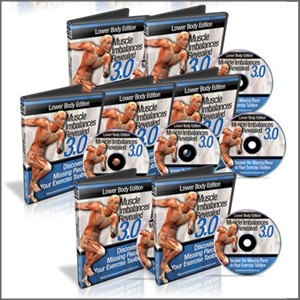The Complete Muscle Imbalances Revealed System
Component #1 Muscular Imbalances in the Hip & Pelvis
In this information packed video webinar, Mike Robertson will introduce you to the importance of the hip and pelvis, plus why so many fitness professionals overlook the hip or pelvis when it comes to injuries and fitness plateaus. During this presentation you will discover the four keys to proper hip function, what Mike Boyle missed in his joint-by-joint stability/mobility approach, the two muscles that are key for better hip function, what Dr. Stuart McGill is missing from the front plank assessment and 3 phases of pelvic stability and alignment.
Component #2 Mobility & Muscle Imbalances
This video webinar is full of rarely discussed details about mobility. Most fitness professionals have no idea of what mobility is, how to assess it or exercises for mobility. This presentation alone will show the missing exercises that most fitness professionals are not doing. These missing exercises can drastically help their clients reach their fitness goals. During the video webinar, Bill Hartman will teach you who should be and who should not be doing mobility exercises, why mobility is not flexibility, 4 exercises to help mid-back mobility and 3 hip mobility assessment tests.
Component #3 Maximizing Strength & Stability of the Knee
The knee is catching up to the back when it comes to injuries and pain. It is important to address the knee if there are any muscle imbalances, injuries or previous injuries in the ankle, knee, hip or lower back. In this video webinar, Rick Kaselj will go through some shocking numbers when it comes to knee injuries, an effective exercise program to prevent knee injuries, a comprehensive program for the recovery of knee injury and a few tidbits about leg extension and the knees passing the toes.
Component #4 Identifying Muscular Imbalances in the Lower Body
f you have made it this far, you know muscle imbalances are vital! In this video webinar, Kevin Yates will give you greater insight into the importance of muscle imbalances, how to identify them, why to identify them and a few assessments on how to do so. Some of the key points in the presentation that you need to make sure you watch for are common lower body injuries due to muscle imbalances, list of injuries due to muscle imbalances, common areas of muscle imbalance and specific assessments for muscle imbalances.
Component #5 Addressing Muscular Imbalances in the Lower Body
You have an idea of the importance of muscle imbalances and how to find them. Now what do you do Kevin Yates goes through a bunch of exercises that help target muscle imbalances that you can use right away. A few of the highlights of this presentation are 3 corrective strategies for the squat, 4 correction strategies for the lunge and stability ball exercises for muscle imbalances.
Component #6 Addressing Muscular Imbalances in the Shoulder
The shoulder is a common area in the upper body where muscle imbalances fester. These muscle imbalances are a big reason for upper body injuries, not getting maximal fitness results and fending off future injuries. Eric Beard will go through these with you, plus 4 components of an injured scapulae, 6 causes of shoulder impairment, 4 effective test for the shoulder and so much more.
Component #7 Fascia, Exercise & Muscle Imbalances
Just like mobility, fascia is often ignored by fitness professionals. If one knows about fascia, often times they don’t know what to do about fascia. Dean Somerset takes care of this for you. In Dean’s presentation he will challenge the anatomy you have learned, explain to you why fascia is important, what you can do about fascia and exercises to address fascia. This is information that you will not find anywhere else.
Component #8 You Can Earn Continuing Education Credits
Muscle Imbalances Revealed has been approved for 0.6 NSCA CEUs, 0.7 ACE CECs, 6.0 BCRPA, 6.0 AFLCA Credits, 6.0 BCAK CEC, 6.0 OFC and CSEP 6 PDC.
Component #9 Muscle Imbalance Exercises for the Lower Body (Value $89)
I received a lot of feedback on Muscle Imbalances Revealed from all the health and fitness professionals around the world, and the number one thing they wanted was MORE EXERCISES. For MIR2, we added more exercises that help address muscle imbalances in the lower body. This is a live presentation where I went through well over 50 exercises to address muscle imbalances in the lower body. Some of them are unique and different but very effective. You get the video of the presentation and a handout with pictures of all the exercises.
Component #10 Fascia, Exercise & Muscle Imbalances Part 2 (Value $68)
The video presentation that received the most feedback and response was the video on fascia. You can see it below (it is called Fascia, Exercise & Muscle Imbalances). Dean Somerset has re-done the one below and added some amazing new information. Plus he has added a second video presentation on fascia. He specifically talks about Training the Myofascial Lines for Back Injuries. Fascia is not commonly taught to fitness professionals and when it is, it’s often explained vaguely and without detail. In Fascia, Exercises & Muscles Imbalances Part 1 and 2, the fascia is explained in great detail. But better yet, he explains how you can address fascia with exercises in order to get better results with your clients.
Component #11 Naked Running (Value $27)
There has been a lot of talk about barefoot running in the fitness industry of late. You maybe wondering if it is a good thing to do or not. You may have seen all those people wearing those funny slipper toed shoes and wondered if they work or are just hype. I have the answers here for you! You have to check this out!
Component #12 Corrective Exercises for Performance
In this ebook, Nick Rosencutter shows you what he did to get back into lifting heavy weights. Nick was lifting heavy and began to develop muscle imbalances which lead to injuries and a decrease in performance. He began to look to see what could help him with his injuries and get him back to lifting heavy. He ended up meeting Mike Robertson and Bill Hartman. Mike and Bill finally figure out what was wrong with Nick and got him on the right path to recovery. Nick shares with you what Mike and Bill showed him, plus what he learned along the way to get from being injured to lifting heavy again.
Component #13 DB Mobility Workout
Kevin Yates of MIRL takes you through a routine that he gives his clients when it relates to mobility. Kevin targets lower and upper body mobility. The exercises are simple and easy for your client to do and only involved a set of dumbbells.
I know this video will give you a little routine that you can give your clients and a number of exercise ideas that you can integrate into your clients and your program.
Component #14 Strategies to Improve Hip & Ankle Mobility
These two videos are going to be hit for any therapist.
Dr. Erson Religoso III shows you how to assess mobility when it relates to the hip & ankle, follows it up with manual therapy techniques that you can use to open up the hip & ankle, highlights some other techniques you can use to improve mobility and wraps up with home exercises that your client can do to build on the manual therapy techniques that you have used.












Reviews
There are no reviews yet.